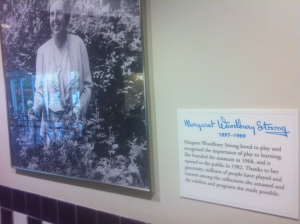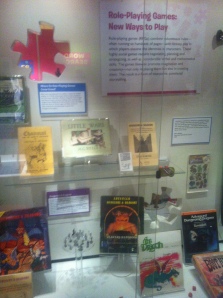The Strong, National Museum of Play
Before last week’s Decoding the Digital conference, I visited the National Museum of play at the Strong. There are a number of Strong endowed institutions in Rochester, including the university Hospital, but unlike the city’s other famous sons and benefactors, George Eastman of Kodak fame, and the Xerox corporation, none of the locals seemed to know who the Strong family was or how they made their money. In contrast to the technological marvels of photography and xerography, the Margaret Woodbury Strong fortune, it turns out, came from the manufacture of whips! Buggy-whips to be precise. Margaret’s family wisely invested some of their whip money in Kodak too, so their fortune grew with that company. She was a keen collector of dolls, who donated her collection, and an endowment, to create the museum.
The Strong actually now contains five institutions (or as they call them, play partners): the National Museum of Play; the National Toy Hall of Fame; the International Center for the History of Electronic Games; the Brian Sutton-Smith Library and Archives of Play; and, the American Journal of Play.
Downstairs the museum mostly resembles the Discovery Centres that grew around the world after (if I recall correctly) the creation of first in Boston: all sorts of opportunities for children from birth to 12(ish) to learn through play, and some handy interpretive panels for parents and other grown-ups to explain just how brilliant learning through play is.
These spaces included a recreation of Sesame Street, but my favorite gallery was the one inspired by comic books, which explored the history of superhero comics, told the stories of some of the classic super-heroes, and offered play experiences based on the theme. The super hero gallery also displayed some of the museum’s collection of classic comic books.
But most of the collection-based displays were upstairs, away from the ludo-didactic spaces on the ground floor. The Toy all of Fame has been selecting toys annually since 1998. All the toys your expect are there: Lego, the Slinky, etc, but some of my favourite exhibits celebrate the play potential of the such brilliant inventions as “the stick” and “the card-board box.”
There’s a big gallery of games, exploring the history of boardgames of all sorts, and including table-top role-playing games like Dungeons and Dragons too. Its funny to see the D&D Basic Set which I remember saving up for, excitedly buying, then being perplexed by, behind the glass of a display cabinet.
But I must admit I spend most time in the video games exhibit, which was not just a collection of vitrines containing historical items from the very first computer game console, SpaceWar and the “brown box” that was the prototype for Pong all the way up to the iPhone (or rather, not an actual iPhone but a label asking “How will the iPhone change video games?” which usefully dates the completion of this gallery to late 2007, early 2008). There was also plenty of video game arcade consoles and pin-ball machine to play, and a machine that sold you five tokens for a dollar.
So I happily played the brilliant Star Wars game, which I remember only ever seeing once on holiday in the US with my parents, in which you control your vector graphics X-wing to defeat a bunch of Tie-fighters and make a run on the Death Star tench to try and hit that infamous exhaust port. Back in Nevada when i was 11, I only had one chance to play that, and lost my last life in the trench. Finally the museum allowed me to have another go and this time, a little bit more experienced with playing video games, I managed to target the exhaust port on my second run and blow up the Death Star. Huzzah! I also managed to get on the high score table on Tempest, another vector graphics game I’d enjoyed in my youth.
Margaret Strong’s own collection of dolls and toys (or at least those bits of it that didn’t appear in other themed galleries) was relegated to a rather dismal gallery about as far from the entrance as it was possible to be. But there was a lovely little space nearby exploring the cold war, entitled “When Barbie Married GI Joe.”
Those were the highlights, but there’s plenty more. Well worth a visit for anybody interested in play.
Oh, one more thing. Just inside the entrance, the museum cafe, is a recreated “diner.” My pre-visit googling had revealed that a local culinary “speciality” is the Garbage Plate (or, as the outlet that invented it rigorously protects its trademark, just Plate in most eateries). The diner at the museum offers one, and it was lunchtime, so I ordered a Plate consisting of “white hots”, saute potatoes, macaroni salad, onions and hot sauce.
My advice?
Don’t.
Just… don’t.








